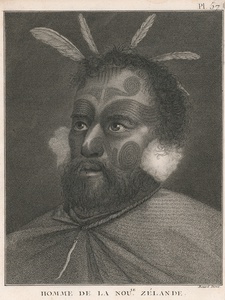| Method | Copper engraving |
| Artist | Jacques Benard after William Hodges |
| Published | [Paris, c.1780] |
| Dimensions | Image 215 x 171 mm, Plate 243 x 185 mm, Sheet 255 x 193 mm |
| Notes |
A portrait of a Māori chief, possibly Te Rangituanui, chief of Ngāti Hikatoa in the Hawke's Bay region of New Zealan ,from Hawkesworth's Relation des Voyages Entrepris par ordre de Sa Majeste Britannique Actuallement Regnante, a French edition of James Cook's Voyages. Te Rangituanui is seen looking off to the left, turned slightly away from the viewer. His face is covered in tattoos, or 'moko', the pattern extending all the way across his forehead, a symbol of his high standing. His hair is decorated with white feathers at the back and tufts of white fur are seen at his ears, known as 'pōhoi toroa' (clusters of albatross down). Robert Bénard (Jacques Bénard) (1734 - 1778) was a French engraver, best known for executing and overseeing the printing of over 1800 illustrative plates for Diderot's seminal Encyclopédie, Dictionnaire raisonné des sciences, des arts et des métiers, par une Société de Gens de lettres. Following designs by Goussier, Benard engravings cover a vast array of topics, from scientific, mathematical, and biological, to heraldic, military, and maritime. The Encyclopédie was a French general encyclopaedia in 28 volumes published in Paris between 1751 and 1772. The general editor of the series was Denis Diderot, the celebrated Enlightenment philosopher, author, and art critic. The broad and ambitious aim of the Encyclopédie was to gather together the collected knowledge of the world into a single work. As a result, some of greatest French minds of the age were contributors, including d'Alembert, Rousseau, and Voltaire. The Encyclopédie played an important role in the development of French intellectual fervour in the lead up to the Revolution. The 17 volumes of articles were accompanied by 11 volumes of illustrative plates, the majority of which were executed by Robert Bénard after drawings by Louis-Jacques Goussier. William Hodges RA (1744-1797) was an English painter. He was a member of James Cook's second voyage to the Pacific Ocean, and is best known for the sketches and paintings he produced of the locations he visited on that voyage. Born in London, Hodges studied under William Shipley and afterwards in the studio of Richard Wilson. During his early career, he made a living by painting theatrical scenery. Between 1772 and 1775 Hodges accompanied James Cook to the Pacific as the expedition's artist. Condition: Trimmed on right margin. Staining to lower sheet edge. Light toning. |
| Framing | unmounted |
| Price | £100.00 |
| Stock ID | 52602 |

